
Animal Bite and Sting Wound Treatment Page Menu: 1 2 3 4 5 6 7 Next>>
Treating Animal Bites and Stings in the Golden Age of Piracy, Page 6
Venomous Animal Wound Treatment: Medicines
Much of the treatment of venomous wounds involved medicines. Some of these were applied externally to draw poisons out, dissipate the venom or serve as an antidote.
Many surgical writers recommended that the surgeon first rinse a venomous wound out with an eye towards removing the poison and/or any foreign remnants left by the attacking animal. Stephen Bradwell says that when "the prick or wound be large enough,
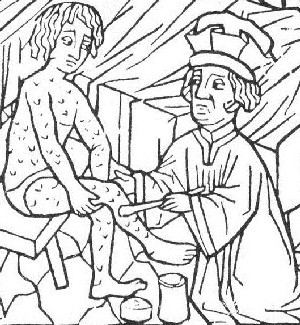
Artist: Batholomaus Steber (1498)
wash it with urine, or salted water, or sharp Vineger, or els with white wine" mixed with theriac or mithridate1. James Cooke likewise suggests that before dressing venomous wounds, "wash with this. Rx. Acet. Vin. acerrim[us] [bitterest wine vinegar] {1 gallon} Sal. Marin. Pul. subtilis. [finely powdered sea salt] {2 ounces} Theriac. {1 ounce} M. {mixed}."2 Paré suggests these wounds be "washed with urine, with sea-water, aqua vitæ, or wine, or vinegar wherein old treacle or mustard shall be dissolved. Let such washing bee performed verie hot, and strongly chased in, and then leav upon the wound and round about it, linnen rags, or lint steeped in the same liquor."3
Notice that the above three wound washes contain several ingredients in common including vinegar, urine and salt.
Physician Robert James explains that vinegar is "no less universally than justly celebrated, on Account of its resolvent [dispersing], anti-septic and refrigerating [cooling] Qualities, for which Reason it is class'd among the Medicines of the alexipharmic [antidote] and anti-pestilential Kind."4
Urine has a long pedigree as a folk remedy for being useful in venomous wounds although it doesn't appear in pharmacopoeias during this period as a recommended remedy. While urine is recognized as antiseptic suggesting it could be useful on such wounds, it is not strong enough to neutralize toxins found in venom.5 No less than Scientific American has weighed in on this in recent years, attesting to the persistence of the myth of the usefulness of urine in treating venomous wounds.6
Salt has a long pedigree in the medical community as being of service in venomous wounds thanks to the revered ancient Roman medical writer Aulus Cornelius Celsus. In his encyclopedia De Medicina, Celsus commented that salt was a remedy for venomous wounds, "and particularly for the bite of a dog, if it be applied dry, and the part be chaffed with two fingers; for it brings out the sanies [serum in the wound]."7 With the words of the ancient physicians still highly regarded during the golden age of piracy, it is no wonder salt (or salt water) was recommended in all these wound washes.
Once the wound was washed, topical applications were applied to the wound and surrounding skin. Garlic and onions were used by several authors. James Cooke employed both sliced and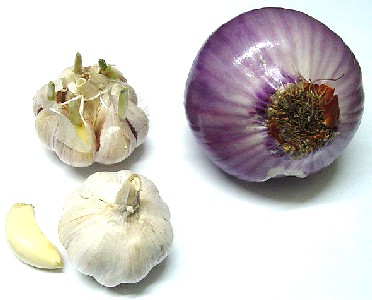
Photo: Wiki Caduser2003 - Garlic and Onion
cooked onions.8 Onions and garlic were both recommended by sea surgeon John Woodall9 and Ambroise Paré as useful topical medicines. Paré added leeks, noting that all three ingredients "are verie good in this case, for that they are vaporous"10. Note that the properties of garlic, onions and leeks were all hot and dry in the fourth degree.11 Garlic was reputed to be "an enemy to all poysons, and such as are bitten by cold venomous beasts, viz. Adders, Toads, Spiders, &c."12 Onions when "bruised and outwardly applyed, they cure the bitings of mad dogs"13.
Animal feces are suggested by a few authors as well. James Cooke advises the creation of a compound ointment containing an ounce of 'Sterc[is]. Caprin[us]' or goat feces. He also suggests another medicines for the same purpose containing "Sterc. Columb. [dove feces] Anat. [duck feces]"14. Similar to Cooke, John Woodall advised the use of 'Fimus columinus' or pigeon’s dung.15 For bee and wasp stings, Ambroise Paré suggested an external application of "Ox-dung macerated [soaked] in oil and vinegar, and applied hot" to remove the pain and dissipate unwanted humors.16 Stephen Bradwell makes a similar suggestion for venomous insect stings using "fresh Cow-dung or dogs dung mixed with sallet Oyle [oil and vinegar]."17 The use of feces may be related to the idea that applying female birds' anuses to venomous wounds would extract the poison, although no such connection is specifically mentioned.
A variety of other ingredients are used for external application with less universal agreement. John Woodall says that all hot medicines of an attractive or drawing faculty are useful such "as Galbanum, Ammoniacum, Bdellium,
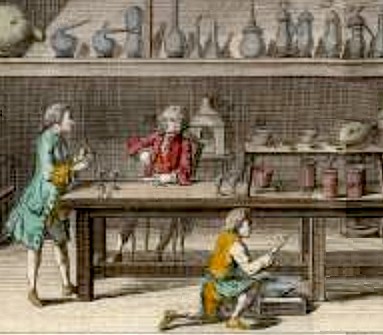
Chemical Laboratory Work, From Encyclopédie, by Denis Diderot (1760)
Emplastrum Diachilon and Divivinum"18. 'Divivinum' is a concoction containing dragon's blood resin, mugwort or artemisia, along with the familiar treacle, garlic and onions, among other ingredients.
Like Woodall, Ambroise Paré suggests other topical medicines he finds useful in venomous wounds. These include "[teucrium] scordium, Rue [Ruta graveolens], [origanum] dictamnus, the lesser Centaurie, hore-hound [Marrubium vulgare], Rocket [eruca sativa], the milkie juice of unripe figs, and the like"19.
When treating venomous wounds, Woodall is a particular fan of artificial balm which he also calls oil of hyperconis. He suggests it be "seething hot... [I] apply it for the first dressing if I feare venome" in a wound.20 This medicine contains a variety of healing ingredients such as turpentine, frankincense, myrrh, gums and aloes. "It is a sure medicine for all venomous wounds, all bitings of madde dogges, or of venomous wormes, very hot applied, and the parts about anointed therewith warme, remembring in all venomous griefes a Cordiall is also requisite."21
Paré similarly recommends the 'juice of hyperconis', which he says has the "power to attract and dispers the poison"22. However he warns that if it works too well, the "heat shall caus such pain as is likely to bring a gangrene by the dissipation of the spirits, then neglecting the cure of the proper diseas for a time, wee must labor to correct the symptom."23
James Cooke advises a couple of custom-made compounds. He recommends an ointment be made which was with sliced onions, theriac or treacle and spirit of wine. Once applied, he suggested the following plaster be spread over it:
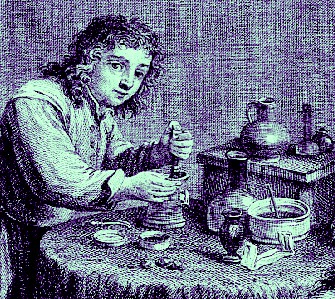
Artist: David Teniers the Younger
Making Medicines, From A Flemish surgeon treating a foot,
Wellcome Collection (17th c.)
Rx. Cepar. Coct. [cooked onions] {3 ounces} Theriac. {1/2 ounce} Sterc[is]. Caprin[us]. [goat feces] {1 ounce} rad. Angelic. Pul. [powdered root of angelica] {1.5 drams} Ol. Scorpion. {1 ounce} Mel. [honey] & Cer. [cerussa or white lead] q. s. [as much as needed] M. f. Empl. [make into a plaster]. This attracts Venom, and corroborates [strengthens] the part.24
Note the number of familiar ingredients mentioned previously in this section. Cooke suggests an alternative plaster as well, which is of some interest.
Rx. Gum Galb[anum]. Sagap[enum]. Opapon[ex]. Asæ-fœtid. [asafoetida] Myrrh. Piper. [pepper] Sulphur. {of each, 6 drams} Sterc. Columb. [dove feces] Anat. [duck feces] {of each, 1 ounce} Mum[mia] {1/2 ounce} rad. Consolid major. pul. [powdered root of comfrey] {3 drams} Ol Hyperic[um]. [oil of St. John's wort] q. s. [as much as needed] f. Empl. [make into a plaster]. This roborates [strengthens] the part, extracts the Venom, produceth matter [pus], and fills the Wound with Flesh.25
Notice that while Cooke gives this plaster properties similar to the previous one, it contains markedly different ingredients.
Ambroise Paré had earlier indicated that poisons often generated heat, suggesting that medicines with 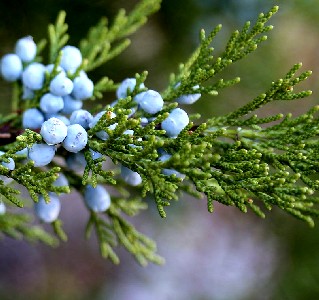
Photo: Wiki User Dcrjsr - Juniper berries (juniperus occidentalis)
cold properties would be preferable in many venomous wounds. (An explanation of the hot and cold properties of medicines can be found here.) However, John Woodall indicates that several 'hot' remedies are good for venomous wounds. For example, he says the use of juniper berries is good for 'venomous bitings', explaining, "Juniper berries are hot in the third degree, drie in the first, and astringent [able to contract the skin and restrict entry of foreign substances]"26 He also recommends melissa (lemon balm) which is "hot in the second, and drie in the first degree... against venome of Scorpions, spider, and Dogges"27. Some venoms were clearly considered cold since Woodall felt such hot remedies were appropriate.
In addition to externally applied medicines, internal remedies were also given to combat the effect of the poison in these wounds. While oral medicines may seem like an unusual choice, Ambroise Paré reasoned that while "they go no further then the stomach; yet do they draw matter out of the joints and head"28. When suggesting oral medicines, Paré advised, "you must give an Antidote, not onely more powerfull then the poison in qualitie, but also greater in quantitie, that so it may the more easily overcome and expel the poison."29 With this in mind, he recommended giving the patient oral antidotes twice a day, continuing to give them "untill you shall know that the strength of the poison is weakned and overcom by the remission and decay of the malign symptoms."30
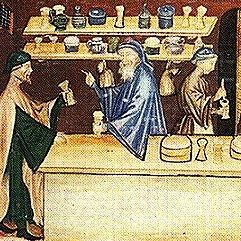
Theriac/treacle Preparation, From
Tacuinum Sanitatis (14th c)
Two compound medicines in particular are recommended by nearly every surgical author under study who talks about envenomed wounds. They were usually given orally, although some authors also added them to their topical remedies.
The first is treacle diatesseron (aka Greek treacle or theriac). Of this, John Woodall says, "It is good against poyson drunken, and against the bitings of venomous beasts or wormes."31 Physician Stephen Bradwell recommends it combined with other simple medicines in a topical ointment "to draw the venom from running inward."32 Surgeon James Cooke also recommends treacle, albeit a slightly different composition. He says that Venice treacle given orally "is admirable, if given for a considerable time."33 He also uses an unspecified type of treacle (possibly London treacle) in external applications as does Paré.34
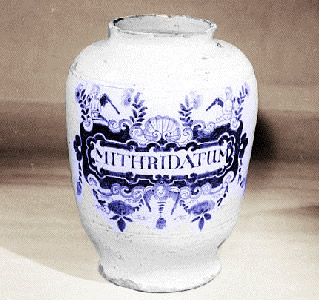
Mithridate Medicine Jar From the Wellcome (18th c.)
The second medicine widely used in venomous wounds is Mithridate, an almost mythical remedy which in some recipes contained as many as 65 different ingredients. Paré explained that it had "a facultie to resist poison, and strengthen the whole bodie", stating that it should be one of only two oral medicines that was allowable in the first three days after a victim had been infected with poison.35
Bradwell recommends it as an alternative to treacle in topical medicines for large wounds. He also combines it with honey in medicines used to draw the poison out of smaller venomous wounds.36 Suggesting a particular type of mithridate - Methridatum Damocratis - John Woodall says that it "is in quallity and vertue like to Treakell, more hotter and forcible against the poison of Serpents, madde Dogs, wilde Beasts, creeping things, being used as a plaster, or drunke"37.
Medicines containing rosemary, borage and bugloss are also suggested by a couple of surgeons.38 However, for the most part, these are not particularly noted for their ability to counteract poisons in the system; even Woodall admits that their use is more to "comfort and confirme the parts diseased"39.
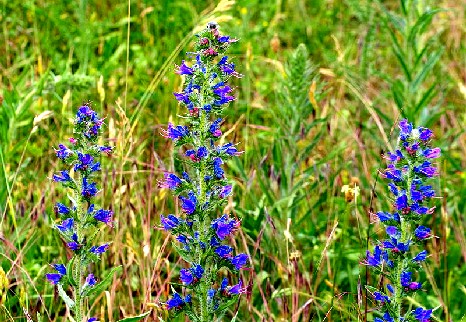
Photo: Andries Eichler - Viper's Bugloss (Echium vulgare) Flower
However, one type of bugloss was renowned for it's ability as an antidote to venoms. Ambroise Paré explained "there is a kinde of wilde bugloss amongst all other plants, which hath a singular force against venomous bites, whence it is termed Ethium and viperinum [viper's bugloss]"40. He says it is called this "becaus it heal’s the biting of a viper not onely applied outwardly, but also helpeth such as are bitten, being drunk in wine, yea, and will not suffer those that have lately drunk thereof to bee bitten at all."41 This is confirmed by physician Nicholas Culpeper who explains "it is a singular remedy being eaten, for the biting of venomous beasts; Continuall eating of it makes the body invincible against the poyson of Serpents, Toads, Spiders &c. however it be adminstred"42.
Paré is also a fan of wild thyme, which he says is as effective as viper's bugloss "in discussing and resolving" the poison injected into a wound.43
As mentioned on the previous page, the phrase "hair of the dog that bit you" refers to the notion that taking a bit of the dog that bit you and ingesting it could prevent rabies. (The Oxford Dictionaries website explains that there is no scientific evidence for this.44) The idea sympathetic attraction of parts of the animal which envenomed the victim was further extended to other venomous animal bites and stings. Ambroise Paré felt that one of the reasons that treacle was such a good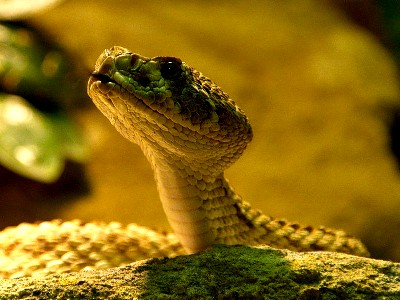
Photo: Cyril Blazy
antidote was because "viper’s flesh enters into the composition of treacle which attracts the venom by the similitude of substance, as the Load-stone draweth iron, or Amber straws."45 (This last comment refers to the fact that amber has electromagnetic properties when rubbed causing it to attract straw.46)
Similar references to this idea appear in the cures for bee and wasp stings, with most of these being applied externally. Matthias Gottfried Purmann recommends a cataplasm for viper bites containing 'Caro Viperina' or viper's skin.47 In bee and wasp sting cases, Paré notes that some surgeons and physicians "applie to the part the same creatures beaten, as wee formerly said of Scorpions; being chawed [chewed] and laid to the part asswage pain."48 German surgeon William Fabry agrees with Paré's assessment of scorpions, noting that "a Scorpion being applied to the bit of a Scorpion doth draw to it his proper poison"49. So does Purmann who advises using oil of scorpions for their stings.50 Along these lines, James Cooke explains that for adder bites some surgeons "to the part apply the Flesh of Adders, and give Wine made of it."51 He also includes oil of scorpions in one of his compound medicines. So there is fairly wide support for the 'hair of the dog' theory of medicine during this period.
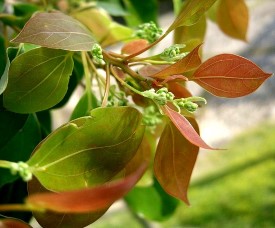
Photo: Wiki User kenpei
Cinnamomum Camphora Rree, Source of Camphor
In addition to these common medicines, German surgeon Matthias Gottfried Purmann gives prescriptions for a couple of custom compound medicines either of which can be given orally when treating venomous bites. These include:
Rx. Spir. Roris marin. [spirit of rosemary] Theriacal. [spirit of treacle camphorated] Lavendul. [spirit of lavender, a cordial], {of each, ½ ounce} Vini Camphor. [camphorated spirit of wine] {2 ounces} Sal Armoniac [ammonium chloride] {1 ounce} Croc. [saffron] {1/2 dram} fiat mixture [make into a mixture] s. ad usum [to use].
...
Rx. Aq. Regin[ae]. Hungar[ica]. [Hungary Water – distilled rosemary in spirit of wine] {1 ounce} Spir vin. [spirit of wine] Camphor. {2 ounces} Theriac. Androm. [Greek treacle] {2 drams} Scord[ium]. [water germander] {1 dram} Sal Marin. [sea salt] {3.5 scruples}, M. f. Mixtura [make into a mixture]52
While not standard medicines, each incorporates some of ingredients already discussed as being of use in treating these wounds.
1 Stephen Bradwell, Helps For Suddain Accidents Endangering Life, 1633, p.39; 2 James Cooke, Mellificium Chirurgiæ: Or, The Marrow of Chiururgery, 1693, p. 111; 3 Ambroise Paré, The Workes of that Famous Chirurgion Ambrose Parey, 1649, p. 510; 4 Robert James, Pharmacopœia universalis, 1747, p. 203; 5 Claudia Hammond, "Can peeing on a snakebite offer relief?", bbc.com, gathered 11/8/16; 6 Ciara Curtin, "Fact of Fiction?: Urinating on a Jellyfish Sting is an Effective Treatment", scientificamerican.com, gathered 11/8/16; 7 A. Cornelius Celsus, Of Medicine in Eight Books, 1756, Translated by James Greive, M.D., p. 293; 8 Cooke, p. 111; 9 John Woodall, the surgions mate, 1617, p. 132; 10 Paré, p. 511; 11 Nicholas Culpeper, A Physical Directory, 1651, pp. 2-4; 12 Culpeper, p. 2; 13 Culpeper, p. 3; 14 Cooke, p. 111; 15 Woodall, p. 132; 16 Paré, p. 522; 17 Bradwell, p.48; 18 Woodall, p. 132; 19 Paré, p. 511; 20 Woodall, p. 132; 21 Woodall, p. 71; 22,23 Paré, p. 511; 24,25 Cooke, p. 111; 26 Woodall, p. 117; 27 Woodall, 120; 28 Paré, p. 512; 29 Paré, p. 511; 30 Paré, p. 512; 31 Woodall, p. 86; 32 Bradwell, p.38; 33 Cooke, p. 111 34,35 Paré, p. 511; 36 Bradwell, p.38; 37 Woodall, p. 84; 38 See for example, Woodall, p. 132 and Matthias Gottfried Purmann, Churgia Curiosa, 1706, p. 187; 39 Woodall, 132; 40,41 Paré, p. 511; 42 Culpeper, p. 18; 43 Paré, p. 511; 44 "What is the origin of the phrase hair of the dog?", oxfordictionaries.com, gathered 11/8/16; 45 Paré, p. 511; 46 Alvah Horton Sabin, The Industrial and Artistic Technology of Paint and Varnish, 1917, p. 29; 47 Matthias Gottfried Purmann, Churgia Curiosa, 1706, p. 188; 48 Paré, p. 511; 49 Guliielm. Fabritius Hildanus aka William Fabry, His Experiments in Chyrurgerie, 1643, p. 20; 50 Purmann, p. 187; 51 Cooke, p. 111; 52 Purmann, p. 187

